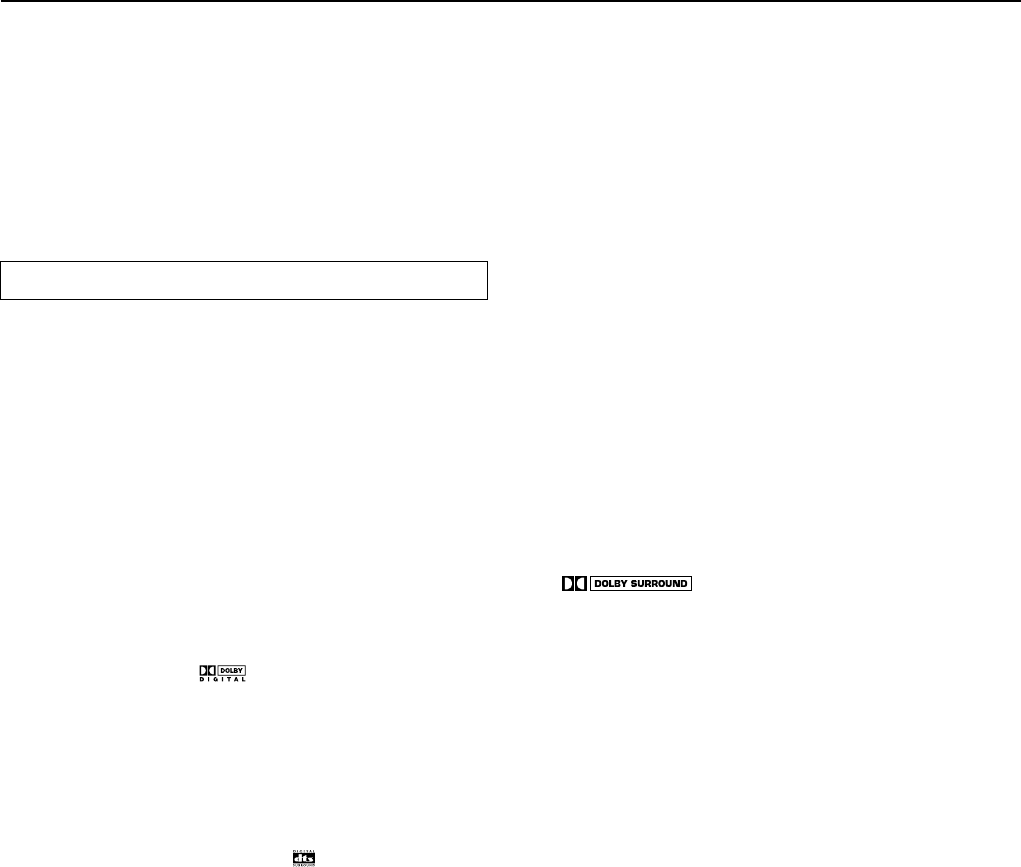
32
Using listening mode
Listening modes
Stereo
This mode has all input sounds output from the left and right front
speakers.
Direct
This mode delivers pure sound with minimum sound quality
adjustment and filtration. The sound recorded for the right and left
front channels is output to the right and left front speakers only and
not output to the subwoofer.
Surround modes
With this mode, decoding is performed automatically to match the
input signal. This original mode adds no sound processing to the
input signal.
• Dolby D (Dolby Digital)
Digital data with AC-3 compression and a maximum of 5.1-
channel* surround sound. This source signal comes from DVDs
and LDs that have the
mark and therefore recorded for
5.1-channel output. This source also comes from digital satellite
broadcasts that support dolby Digital.
• DTS
DTS (Digital Theater System) is compressed digital data with a
maximum 5.1-channel* surround output that allows for an
extremely high-quality sound. This source signal requires a
DVD player that supports DTS output and comes from compact
discs, DVDs, and LDs that have the
mark.
Notes on DTS:
• If you play a CD or LD that supports DTS when the “Analog”
setting is selected on the DTR-6.2, the DTS encoded signal
will not be decoded and noise will be output. This noise could
damage the amplifier and speakers. Therefore, be sure to
selected “Auto” and use the digital input jacks (OPTICAL or
COAXIAL) to connect the DTS source.
• The DTS indicator on the DTR-6.2 lights while a DTS source
is played. When playback finishes and the DTS signal
transmission stops, the DTR-6.2 remains in DTS mode and
the DTS indicator remains lit. This prevents noise when you
operate the pause or skip button on the player. Therefore, if
the source is immediately switched from DTS to PCM, the
PCM signal may not be played. In this case, stop the playback
of the source on the player for about three seconds and then
resume playback.
• If you press the pause or skip button on the player while
playing a DTS source, on rare occasions a short noise may be
heard. This is not a malfunction.
• You may not be able to play some DTS source signals from
certain CD players and LD players even if you connect the
player to the DTR-6.2 digitally. This is because the digital
signal has been processed (such as the output level, sampling
frequency, or frequency response) and the DTR-6.2 cannot
recognize the signal as DTS data. Therefore you may hear
noise when you play a DTS source while processing the
signal.
The DTR-6.2’s surround sound enables you to enjoy the presence of
a movie theater or concert hall in your room.
The configuration of the speakers are very important for the
surround sound. Refer to “Connecting speakers” on page 17.
Before using a listening mode, make sure the Speaker Setup
parameters have been set (refer to page 24-26). Once the parameters
have been set, it is not necessary to set them again.
• The outputs for the VIDEO 1 OUT, VIDEO 2 OUT, TAPE
OUT, output analog audio signals. Do not record from CDs or
LDs that support DTS using these outputs. If you do, the
DTS-encoded signal will be recorded as noise.
* The 5.1-channel digital surround format has a variety of versions
including Dolby Digital and DTS. The 5.1- channel digital
surround format enables you to individually record and play five
full-range (20 Hz to 20 kHz) channels (left and right front,
center, and two surround channels) plus an LFE channel (Low
Frequency Effect) for the low-range effect sound. It will create a
realistic sound that can be heard in the theaters and concert halls.
• DOLBY PRO LOGIC II Surround
This mode is a new generation 5-channel surround system that
provides performance between the 4-channel (left front, right
front, center, and monaural surround) Pro Logic Surround and
the 5.1-channel Dolby Digital Surround. This mode can be set to
the Movie mode designed for playing movies and the Music
mode designed for listening to music. In the Movie mode, the
surround channels, which used to provide monaural output over
only a narrow frequency range, now provide complete stereo
output over the full frequency range. The result is movie viewing
with a realistic feel of movement. The Music mode uses the
surround channels to provide a natural sound space that cannot
be provided with normal stereo output.
This mode can be used with VHS and DVD videos with the
mark and certain television programs. The
Music mode can be used with music compact discs and other
stereo sources.
You can press the SURR button on the remote controller to
switch between MOVIE and MUSIC. The initial setting is
MOVIE. This setting can be made for each input source.
If no surround speakers are connected, then the surround sound
is divided and output from the front left and right channels (3
stereo).
Orchestra
This mode is appropriate for classical and opera music. The center
channel is cut and the surround channels are emphasized to widen
the stereo image. It will simulate the natural reverberation that is
created in large halls.
TV Logic
This mode gives realistic acoustics to TV programs that are aired
from TV studios. It enhances the entire surround sound and clarity of
the conversation.
Unplugged
This mode is suitable for acoustical instrumental sounds, vocals, and
jazz music. By emphasizing the front stereo image, it will simulate
the acoustics that you would experience in front of the stage.
Studio-Mix
This mode is for rock and popular music. The lively sounds are
enhanced for a powerful acoustic image that simulates the feeling of
being in a club or rock concert.
All Ch Stereo
This mode is designed for playing background music. The front,
surround, and surround back channels create a stereo image that
encompasses the entire area.


















